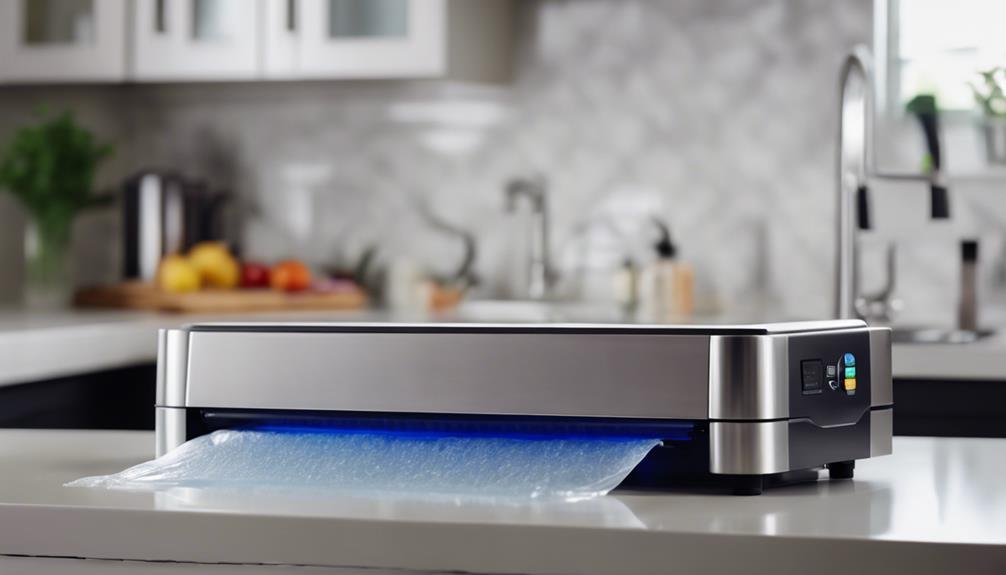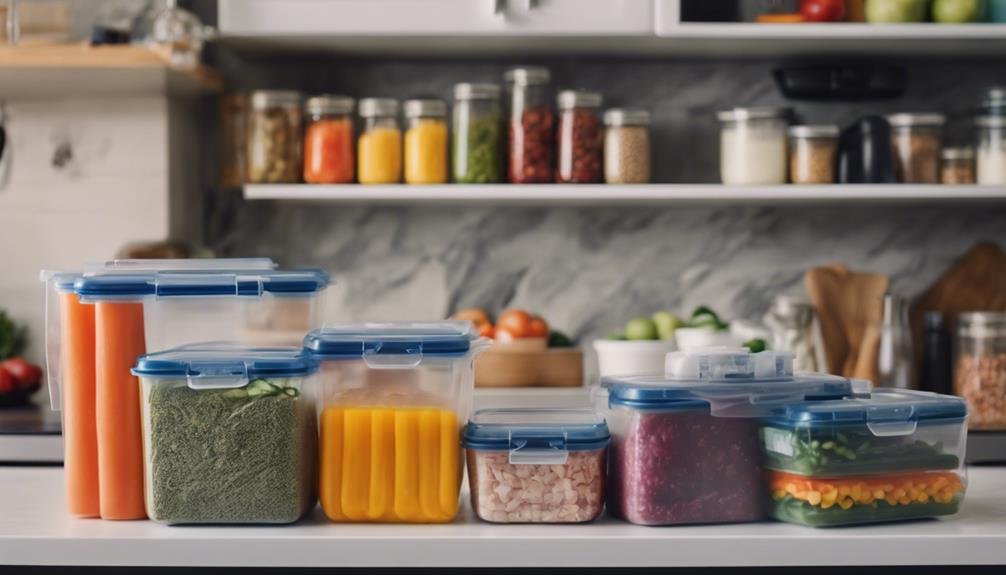Vacuum sealing is an effective way to prevent cross-contamination in your kitchen. It creates a physical barrier that stops harmful microorganisms from spreading between foods. By sealing different items separately, you'll reduce the risk of contamination during storage. Proper labeling and organization of vacuum-sealed packages help maintain food safety and extend shelf life. Clean your vacuum sealer regularly and follow hygienic practices when handling food. When thawing sealed items, use the refrigerator method to preserve quality and minimize bacterial growth. Incorporating vacuum sealing into your kitchen routine not only prevents cross-contamination but also saves money and reduces waste. Discover how this simple technique can revolutionize your food safety practices.
Understanding Cross-Contamination Risks
Cross-contamination's a serious risk in your kitchen, but you've got a powerful ally in vacuum sealing to combat it. Understanding this threat is important for maintaining food safety in your home. Cross-contamination occurs when harmful microorganisms transfer from one food item to another, potentially leading to foodborne illnesses.
Vacuum sealing offers an effective solution to this problem. By creating a physical barrier around your food, it prevents the spread of bacteria and other pathogens. When you seal items individually, you're greatly reducing the risk of cross-contamination during storage and preparation.
But vacuum sealing isn't just about wrapping food in plastic. It's a thorough approach to food safety that includes proper labeling and storage practices. By clearly marking each sealed package, you'll avoid mix-ups that could lead to unintended contamination.
Benefits of Vacuum Sealing
With the risks of cross-contamination in mind, let's explore the specific benefits that vacuum sealing offers to keep your kitchen safe and hygienic.
One of the main advantages of using a vacuum sealer is its ability to prevent cross-contamination effectively. By creating an airtight barrier around individual food items, you're establishing a vital shield that keeps harmful microorganisms from transferring between different foods. This separation is essential in maintaining food safety and ensuring that each item remains uncontaminated.
When you vacuum seal your food, you're not only preserving its freshness but also minimizing the risk of foodborne illnesses. The sealed packages act as a safeguard against potential contaminants, allowing you to store various food items together without worry. This method is particularly beneficial when handling raw meats, seafood, or other potentially hazardous foods.
Moreover, vacuum sealing can significantly extend the shelf life of your food, reducing waste and saving you money in the long run. By implementing this technology in your kitchen, you're taking a proactive step towards upholding proper food hygiene practices. It's an investment in your health and safety, providing peace of mind with every meal you prepare.
Proper Food Storage Techniques

To maximize the benefits of vacuum sealing, you'll need to master proper food storage techniques that complement this effective cross-contamination prevention method.
When vacuum sealing food, start by carefully separating different types of items to prevent any potential mixing. Make sure each food item is properly cleaned and dried before sealing to maintain hygiene.
Label your vacuum-sealed bags clearly with the contents and date of sealing. This practice not only helps you identify items easily but also assists in maintaining a well-organized storage system.
When storing sealed bags, place them in appropriate areas of your refrigerator or freezer, keeping raw meats separate from ready-to-eat foods.
Always follow safety guidelines for vacuum sealing to maintain a hygienic kitchen environment. Clean and sanitize your vacuum sealer and work surfaces before and after use to prevent cross-contamination. When opening sealed bags, use clean utensils and avoid touching the contents directly.
Organizing Your Refrigerator
When you're organizing your refrigerator, it's important to leverage vacuum sealing for the best food safety and storage efficiency. Start by using vacuum-sealed bags to separate raw meat from other foods, preventing cross-contamination. This simple step can greatly reduce the risk of foodborne illnesses in your kitchen.
To keep track of your vacuum-sealed food, label and date each package. This practice helps you easily identify contents and guarantees you consume items before they spoil.
When you store food in your refrigerator, place vacuum-sealed bags on different shelves to avoid any potential drips or leaks onto other items. Maximize space and airflow by keeping vacuum-sealed bags upright and organized. This arrangement promotes efficient cooling and helps maintain the freshness of your food.
Don't forget to regularly clean your refrigerator shelves and drawers to create a sanitary environment for storing vacuum-sealed foods.
Sanitizing Vacuum Sealing Equipment

You can't overlook the importance of sanitizing your vacuum sealing equipment to maintain a hygienic kitchen environment. Proper cleaning and sanitization of your vacuum sealer are vital steps in preventing cross-contamination and ensuring food safety.
After each use, clean your equipment with hot, soapy water to remove any food residue. Pay special attention to the sealing bar and gaskets, as these areas can harbor harmful bacteria if not properly sanitized. Use food-safe disinfectants or sanitizing solutions to thoroughly clean all parts of your vacuum sealer.
Here's a simple guide to help you maintain your vacuum sealing equipment:
| Step | Action | Frequency |
|---|---|---|
| 1 | Clean with hot, soapy water | After each use |
| 2 | Sanitize sealing bar and gaskets | Weekly |
| 3 | Use food-safe disinfectants | Monthly |
| 4 | Allow to dry completely | After cleaning |
Handling Raw Meats Safely
Properly handling raw meats is essential for preventing cross-contamination and maintaining a safe kitchen environment. Vacuum sealing is an effective method to create a barrier between raw meats and other foods, reducing the risk of harmful bacteria spreading. When you vacuum seal raw meats, you're taking an important step in ensuring food safety and preserving freshness.
To handle raw meats safely and prevent cross-contamination, follow these important steps:
- Use separate cutting boards and utensils for raw meats
- Store vacuum-sealed raw meats separately from ready-to-eat foods
- Sanitize all surfaces and equipment after handling raw meats
- Wash your hands thoroughly before and after touching raw meats
Remember, even when vacuum sealing raw meats, it's essential to maintain proper food safety practices. Always store sealed meats in the refrigerator or freezer promptly after packaging.
By implementing these measures, you'll greatly reduce the risk of cross-contamination in your kitchen.
Vacuum sealing is an excellent tool for food preservation, but it's not a substitute for safe handling practices. By combining vacuum sealing with proper food safety techniques, you'll create a safer, more hygienic kitchen environment for you and your family.
Preserving Leftovers Effectively

Vacuum sealing isn't just for raw meats; it's an excellent method for preserving your leftovers effectively. This preservation method creates a barrier between your food and external contaminants, greatly reducing the risk of cross-contamination. By removing air from the storage container, you're not only protecting your leftovers from potential hazards but also extending their shelf life.
When you vacuum seal your leftovers, you're taking a proactive step in food safety. This technique helps prevent bacterial growth and spoilage, ensuring that your meals remain fresh for longer periods. Whether you're storing your leftovers in the refrigerator or freezer, vacuum sealing maintains their taste and texture, allowing you to enjoy them as if they were freshly prepared.
This method is particularly useful for potentially hazardous foods that are prone to quick spoilage. By incorporating vacuum sealing into your kitchen routine, you're not only safeguarding your family's health but also minimizing food waste. It's a simple yet effective way to preserve the quality of your leftovers, giving you peace of mind and reducing the risk of foodborne illnesses in your home.
Labeling and Dating Sealed Packages
An essential step in the vacuum sealing process is labeling and dating your sealed packages, which can't be overlooked for maintaining an organized and safe kitchen. By implementing a labeling system for your vacuum sealed packages, you'll guarantee that you can easily identify contents and track freshness. This practice not only reduces confusion but also helps you prioritize consumption based on packaging dates.
Clear labeling offers several benefits for your kitchen organization and food safety:
- Prevents accidental mix-ups between similar-looking packages
- Allows for efficient rotation of food items to maintain quality
- Simplifies inventory management, reducing food waste
- Helps you quickly locate specific items in storage
When labeling your vacuum sealed packages, be sure to include the contents and the date of packaging. This information will guide you in using older items first and maintaining the freshness of your stored food.
Thawing Vacuum-Sealed Foods

When it comes to thawing vacuum-sealed foods, you'll need to follow specific guidelines to maintain safety and quality. The best method for thawing vacuum-sealed foods is in the refrigerator. This slow thawing process helps slow down microbial growth, ensuring food safety and preserving the texture and flavor of your food.
It's important to avoid thawing vacuum-sealed foods at room temperature, as this can increase the risk of bacterial contamination. Similarly, you shouldn't use cold water or microwave thawing methods for these items, as they can compromise the seal and potentially lead to cross-contamination.
Proper thawing techniques are essential for minimizing food safety risks. By using your refrigerator, you're creating a controlled environment that maintains the integrity of the vacuum seal while allowing the food to thaw safely. This method also helps prevent cross-contamination, which is especially important when dealing with raw meats or seafood.
Maintaining Kitchen Hygiene Standards
To maintain excellent hygiene standards in your kitchen, you'll need to implement effective strategies that go beyond basic cleaning practices. One powerful tool in your arsenal against cross-contamination is vacuum sealing. This method creates a barrier between different food items, greatly reducing the risk of harmful microorganisms transferring from one food to another.
Vacuum sealing plays an important role in maintaining kitchen hygiene standards by:
- Preventing contact between raw and cooked foods
- Minimizing exposure to potential contaminants in the environment
- Allowing for safer storage of individual portions
- Reducing the spread of bacteria during food preparation
Conclusion
You've mastered the art of vacuum sealing, but don't let your guard down just yet. The battle against cross-contamination never ends. Will you remember to sanitize your equipment?
Can you resist the temptation to overfill your fridge? Stay vigilant, and you'll keep your kitchen a safe haven.
With each perfectly sealed package, you're not just preserving food—you're safeguarding your family's health. The power's in your hands. Use it wisely.
